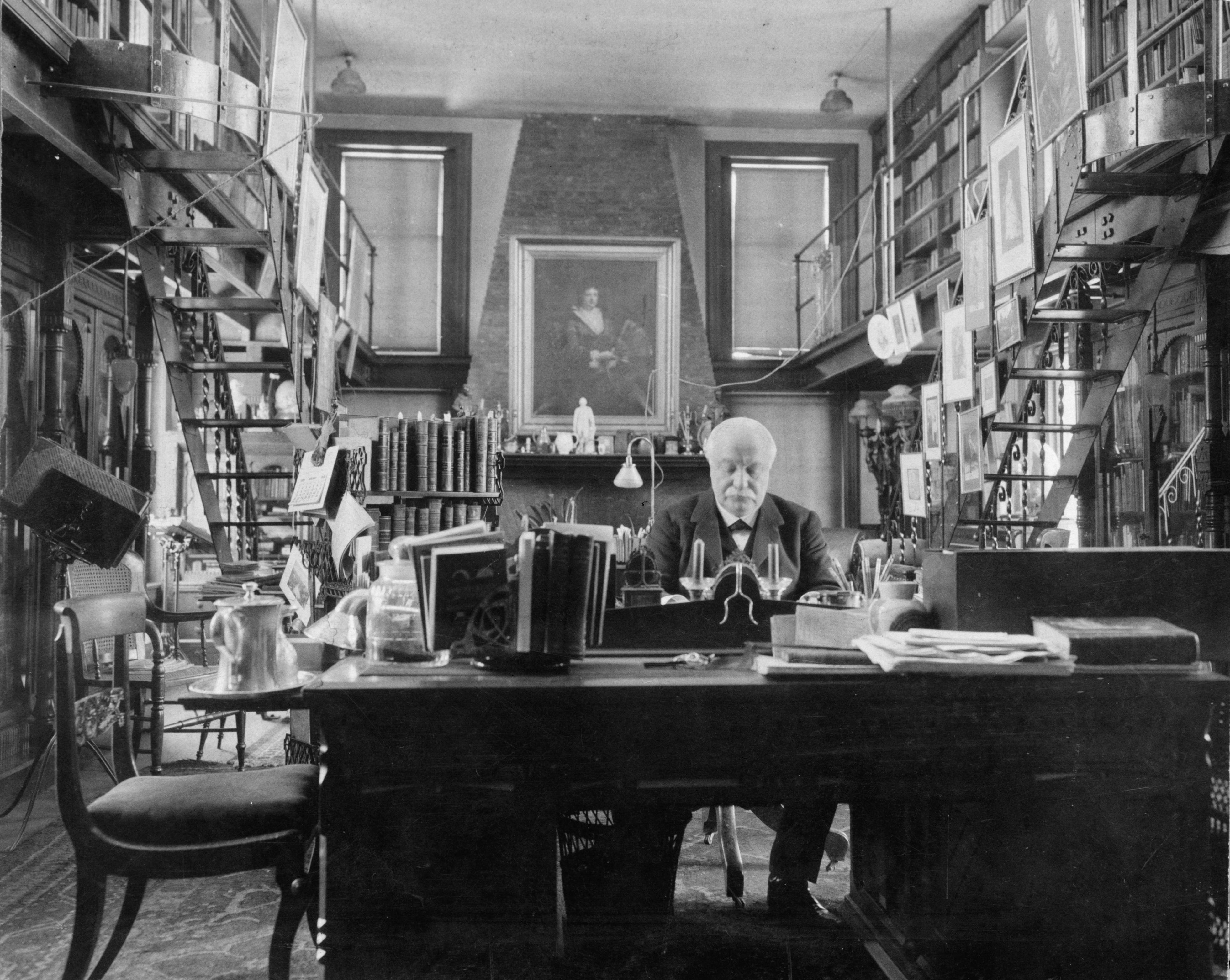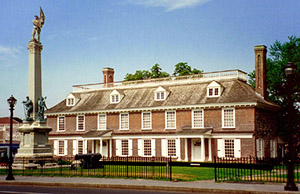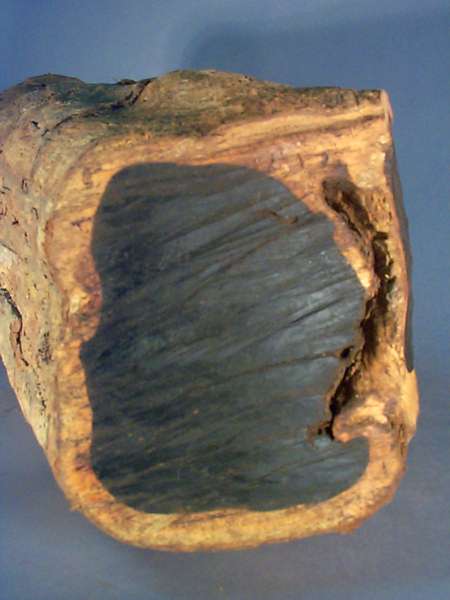|
Glenview Mansion
Glenview Mansion, listed on the National Register of Historic Places as the John Bond Trevor House, is located on Warburton Avenue in Yonkers, New York, United States. It is a stone house erected during the 1870s in an eclectic Late Victorian architectural style from a design by Charles W. Clinton. It was listed on the Register in 1972. It is one of the few remaining buildings in Yonkers made of locally quarried greystone. Inside there is fine Eastlake cabinetry by the prominent Philadelphia cabinetmaker Daniel Pabst and other decorations and finishes; it is considered one of the finest interiors in that style in an American building open to the public. Financier John Bond Trevor built the house as a small country estate that was nevertheless close enough to New York City to allow him to commute to his job in the city by rail. At the time he and his family moved in, it was surrounded by similar houses. By the time Trevor's second wife died in the early 1920s, Glenview had beco ... [...More Info...] [...Related Items...] OR: [Wikipedia] [Google] [Baidu] |
Daniel Pabst
Daniel Pabst (June 11, 1826 – July 15, 1910) was a German-born American Victorian decorative arts#Furniture, cabinetmaker of the Victorian Era. He is credited with some of the most extraordinary custom interiors and hand-crafted furniture in the United States. Sometimes working in collaboration with architect Frank Furness (1839–1912), he made pieces in the Renaissance Revival, Neo-Grec, Modern Gothic, and Colonial Revival styles. Examples of his work are in the collections of the Metropolitan Museum of Art, the Philadelphia Museum of Art, the Art Institute of Chicago, and the Victoria and Albert Museum in London. Background Born in Kirchhain#Town_divisions, Langenstein, Hesse, Germany, Pabst immigrated to the U.S. in 1849 and settled in Philadelphia, Pennsylvania, where he would make his professional career. The excellence of his craftsmanship elevated him above his peers, as did the strongly architectonic (building-like) quality of his furniture designs—often massively s ... [...More Info...] [...Related Items...] OR: [Wikipedia] [Google] [Baidu] |
Yonkers, New York
Yonkers () is a city in Westchester County, New York, United States. Developed along the Hudson River, it is the third most populous city in the state of New York, after New York City and Buffalo. The population of Yonkers was 211,569 as enumerated in the 2020 United States Census. It is classified as an inner suburb of New York City, located directly to the north of the Bronx and approximately two miles (3 km) north of Marble Hill, Manhattan, the northernmost point in Manhattan. Yonkers's downtown is centered on a plaza known as Getty Square, where the municipal government is located. The downtown area also houses significant local businesses and nonprofit organizations. It serves as a major retail hub for Yonkers and the northwest Bronx. The city is home to several attractions, including access to the Hudson River, Tibbetts Brook Park, with its public pool with slides and lazy river and two-mile walking loop Untermyer Park; Hudson River Museum; Saw Mill River daylig ... [...More Info...] [...Related Items...] OR: [Wikipedia] [Google] [Baidu] |
Gable
A gable is the generally triangular portion of a wall between the edges of intersecting roof pitches. The shape of the gable and how it is detailed depends on the structural system used, which reflects climate, material availability, and aesthetic concerns. The term gable wall or gable end more commonly refers to the entire wall, including the gable and the wall below it. Some types of roof do not have a gable (for example hip roofs do not). One common type of roof with gables, the gable roof, is named after its prominent gables. A parapet made of a series of curves (Dutch gable) or horizontal steps (crow-stepped gable) may hide the diagonal lines of the roof. Gable ends of more recent buildings are often treated in the same way as the Classic pediment form. But unlike Classical structures, which operate through trabeation, the gable ends of many buildings are actually bearing-wall structures. Gable style is also used in the design of fabric structures, with varying degree ... [...More Info...] [...Related Items...] OR: [Wikipedia] [Google] [Baidu] |
Sitting Room
In Western architecture, a living room, also called a lounge room ( Australian English), lounge (British English), sitting room (British English), or drawing room, is a room for relaxing and socializing in a residential house or apartment. Such a room is sometimes called a front room when it is near the main entrance at the front of the house. In large, formal homes, a sitting room is often a small private living area adjacent to a bedroom, such as the Queens' Sitting Room and the Lincoln Sitting Room of the White House. In the late 19th or early 20th century, Edward Bok advocated using the term ''living room'' for the room then commonly called a '' parlo '' or ''drawing room'', and is sometimes erroneously credited with inventing the term. It is now a term used more frequently when referring to a space to relax and unwind within a household. Within different parts of the world, living rooms are designed differently and evolving, but all share the same purpose, to gather ... [...More Info...] [...Related Items...] OR: [Wikipedia] [Google] [Baidu] |
Encaustic Tile
Encaustic tiles are ceramic tiles in which the pattern or figure on the surface is not a product of the glaze but of different colors of clay. They are usually of two colours but a tile may be composed of as many as six. The pattern appears inlaid into the body of the tile, so that the design remains as the tile is worn down. Encaustic tiles may be glazed or unglazed and the inlay may be as shallow as , as is often the case with "printed" encaustic tile from the later medieval period, or as deep as a quarter inch. History What were called encaustic tiles in the Victorian era were originally called inlaid tiles during the medieval period. The use of the word "encaustic" to describe an inlaid tile of two or more colors is linguistically incorrect. The word encaustic from grc, ἐγκαυστικός means "burning in" from the ''en'', "in" and ''kaiein'', "to burn". The term originally described a process of painting with a beeswax-based paint that was then fixed with heat. I ... [...More Info...] [...Related Items...] OR: [Wikipedia] [Google] [Baidu] |
Victorian Majolica
Victorian majolica properly refers to two types of majolica made in the second half of the 19th century in Europe and America. Firstly, and best known, there is the mass-produced majolica decorated with coloured lead glazes, made in Britain, Europe and the US; typically hard-wearing, surfaces moulded in relief, vibrant translucent glazes, in occasionally classical but mostly naturalistic styles, often with an element of High Victorian whimsy. Secondly, there is the much less common tin-glazed majolica made primarily by Mintons from 1848 to circa 1880, typically with flat surfaces, opaque white glaze with fine brush painted decoration in imitation of the Italian Renaissance maiolica process and styles. Glazes Glaze is a vitreous coating on a ceramic. There are four types of glazing: feldspathic or alkali-glazed, salt-glazed, lead-glazed, and tin-glazed. It is important to understand that lead oxide is the main ingredient of both lead ''and'' tin glazes. Lead oxide is a flux ... [...More Info...] [...Related Items...] OR: [Wikipedia] [Google] [Baidu] |
Ebony
Ebony is a dense black/brown hardwood, coming from several species in the genus ''Diospyros'', which also contains the persimmons. Unlike most woods, ebony is dense enough to sink in water. It is finely textured and has a mirror finish when polished, making it valuable as an ornamental wood. The word ''ebony'' comes from the Ancient Egyptian ', through the Ancient Greek ('), into Latin and Middle English. Species Species of ebony include ''Diospyros ebenum'' (Ceylon ebony), native to southern India and Sri Lanka; '' D. crassiflora'' (Gabon ebony), native to western Africa; and '' D. celebica'' (Sulawesi ebony), native to Indonesia and prized for its luxuriant, multi-colored wood grain. Mauritius ebony, '' D. tessellaria'', was largely exploited by the Dutch in the 17th century. Some species in the genus yield an ebony with similar physical properties, but striped rather than the even black of ''D. ebenum''. Uses Ebony has a long history of use, and carved pieces have be ... [...More Info...] [...Related Items...] OR: [Wikipedia] [Google] [Baidu] |
Woodcarving
Wood carving is a form of woodworking by means of a cutting tool (knife) in one hand or a chisel by two hands or with one hand on a chisel and one hand on a mallet, resulting in a wooden figure or figurine, or in the sculptural ornamentation of a wooden object. The phrase may also refer to the finished product, from individual sculptures to hand-worked mouldings composing part of a tracery. The making of sculpture in wood has been extremely widely practised, but doesn't survive undamaged as well as the other main materials like stone and bronze, as it is vulnerable to decay, insect damage, and fire. Therefore, it forms an important hidden element in the art history of many cultures. Outdoor wood sculptures do not last long in most parts of the world, so it is still unknown how the totem pole tradition developed. Many of the most important sculptures of China and Japan, in particular, are in wood, and so are the great majority of African sculpture and that of Oceania and ... [...More Info...] [...Related Items...] OR: [Wikipedia] [Google] [Baidu] |
Turning (woodworking)
Woodturning is the craft of using a wood lathe with hand-held tools to cut a shape that is symmetrical around the axis of rotation. Like the potter's wheel, the wood lathe is a simple mechanism that can generate a variety of forms. The operator is known as a turner, and the skills needed to use the tools were traditionally known as turnery. In pre-industrial England, these skills were sufficiently difficult to be known as 'the misterie' of the turners guild. The skills to use the tools by hand, without a fixed point of contact with the wood, distinguish woodturning and the wood lathe from the machinist's lathe, or metal-working lathe. Items made on the lathe include tool handles, candlesticks, egg cups, knobs, lamps, rolling pins, cylindrical boxes, Christmas ornaments, bodkins, knitting needles, needle cases, thimbles, pens, chessmen, spinning tops; legs, spindles, and pegs for furniture; balusters and newel posts for architecture; baseball bats, hollow forms such as woodwind ... [...More Info...] [...Related Items...] OR: [Wikipedia] [Google] [Baidu] |
Balustrade
A baluster is an upright support, often a vertical moulded shaft, square, or lathe-turned form found in stairways, parapets, and other architectural features. In furniture construction it is known as a spindle. Common materials used in its construction are wood, stone, and less frequently metal and ceramic. A group of balusters supporting a handrail, coping, or ornamental detail are known as a balustrade. The term baluster shaft is used to describe forms such as a candlestick, upright furniture support, and the stem of a brass chandelier. The term banister (also bannister) refers to a baluster or to the system of balusters and handrail of a stairway. It may be used to include its supporting structures, such as a supporting newel post. Etymology According to the ''Oxford English Dictionary'', "baluster" is derived through the french: balustre, from it, balaustro, from ''balaustra'', "pomegranate flower" rom a resemblance to the swelling form of the half-open flower (''illus ... [...More Info...] [...Related Items...] OR: [Wikipedia] [Google] [Baidu] |
Bracket (architecture)
A bracket is an architectural element: a structural or decorative member. It can be made of wood, stone, plaster, metal, or other media. It projects from a wall, usually to carry weight and sometimes to "...strengthen an angle". A corbel or console are types of brackets. In mechanical engineering a bracket is any intermediate component for fixing one part to another, usually larger, part. What makes a bracket a bracket is that it is intermediate between the two and fixes the one to the other. Brackets vary widely in shape, but a prototypical bracket is the L-shaped metal piece that attaches a shelf (the smaller component) to a wall (the larger component): its vertical arm is fixed to one (usually large) element, and its horizontal arm protrudes outwards and holds another (usually small) element. This shelf bracket is effectively the same as the architectural bracket: a vertical arm mounted on the wall, and a horizontal arm projecting outwards for another element to be attached o ... [...More Info...] [...Related Items...] OR: [Wikipedia] [Google] [Baidu] |
Volute
A volute is a spiral, scroll-like ornament that forms the basis of the Ionic order, found in the capital of the Ionic column. It was later incorporated into Corinthian order and Composite column capitals. Four are normally to be found on an Ionic capital, eight on Composite capitals and smaller versions (sometimes called ''helix'') on the Corinthian capital. The word derives from the Latin ''voluta'' ("scroll"). It has been suggested that the ornament was inspired by the curve of a ram's horns, or perhaps was derived from the natural spiral found in the ovule of a common species of clover native to Greece. Alternatively, it may simply be of geometrical origin."Volute". ''The Concise Oxford Dictionary of Archaeology''. Timothy Darvill. Oxford University Press, 2002 The ornament can be seen in Renaissance and Baroque architecture and is a common decoration in furniture design, silverware and ceramics. A method of drawing the complex geometry was devised by the ancient Roman arch ... [...More Info...] [...Related Items...] OR: [Wikipedia] [Google] [Baidu] |










.jpg)